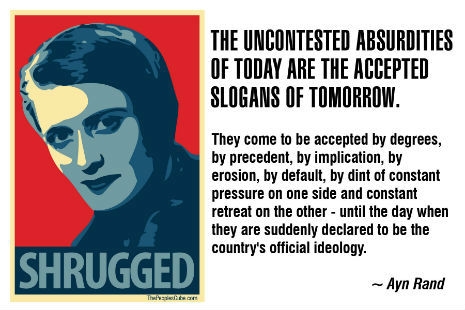
Famed Libertarian economist and activist Murray Rothbard wrote the scathing one-act play “Mozart Was A Red” in the early 1960s satirizing Ayn Rand and her slavish cult of personality.
If you have even a passing familiarity with how Rand interacted with her court follower “Objectivists,” then “Mozart Was a Red” is absolutely hysterical stuff.
Here’s how Justin Raimondo described the play on a Libertarian website. This sets the stage nicely, indeed.
“Mozart Was a Red” is, to my knowledge, Murray N. Rothbard’s one and only play. It is a form unusual for him, but one well suited to its subject: the cult that grew up around the novelist Ayn Rand and flourished in the 60s and early 70s. For the principal figures of Rand’s short-lived “Objectivist” movement were indeed like characters out of some theatrical farce.
With her flowing cape, intense eyes, and long cigarette holder, Rand was the very picture of eccentricity; she sometimes wore a tricornered hat, and at one point carried a gold-knobbed cane. Her thick Russian accent added to the exoticism. It is a measure of Rand’s powerful personality – and the real key to understanding the Rand cult – that, after a while, many of her leading followers began to speak with a noticeable accent, although each and every one of them had been born in North America.
This Russification process was especially pronounced in Nathaniel Branden, her leading disciple. Branden delivered his lectures on the “Basic Principles of Objectivism” in a sonorous singsong voice with a very definite Slavic undertone. Pompous, dogmatic, and utterly self-infatuated, Branden was the second-in-command and chief enforcer of a cult that demanded total obedience and agreement on every conceivable subject – in the name of individualism. Any deviation from the Randian line – and they had a line on everything – was taken as evidence of “bad premises,” and grounds for expulsion from the inner circle.
Murray’s own experience with the Randians was a case in point. In the late 50s, Murray and a group of his libertarian friends in New York City became interested in the burgeoning Objectivist movement, which had taken off as a result of the success of Rand’s novel, Atlas Shrugged.
Murray wrote Rand a letter complimenting her on the novel, and soon joint meetings of the Randian “Senior Collective” and Rothbard’s Circle Bastiat were being held. As advocates of laissez-faire capitalism, avowedly committed to the supremacy of reason, it seemed as if the Randians would be valuable allies.
But the Randians did not understand the concept of “allies”: in their universe, you either agreed with all of their positions, or else you were consigned to the Outer Darkness. (Curiously, on the level of macro-politics, the Randians were grossly opportunistic.)
The Randian ideology was not so much an integrated philosophical system as a mythos, based as it was on Rand’s novels. Unfortunately, as she got older, she imagined herself to be a philosopher, and gave up fiction writing to become the leader of a movement.
In her nonfiction tirades, Rand quotes mainly from her own works; this was due not only to her inflated self-estimate, but also to a colossal ignorance. She read almost nothing but detective novels, and her followers, usually considerably younger, were even worse. Although her philosophy of rational self-interest was an eccentric modern variation on a much older philosophical tradition, the only precedent she acknowledged was Aristotle.
While claiming not to be militant atheist – “It would be paying religion a compliment it does not deserve” – she denounced conservatives for their devotion to religion and tradition, dismissing them as “moth-eaten mystics.”
Religion was also the main issue in the events leading up to Murray’s break with the Randians: although Murray was an agnostic, his wife, JoAnn, was (and is) a Presbyterian. Apprised of this, Rand grilled Joey on the reasons for her religious faith and suggested that she read a pamphlet put out by the Randians that “disproved” the existence of God.
When Joey refused to recant her heresy, Murray was told that he had better find himself a more “rational” mate. That was enough for Murray. The break was finalized by his formal “trial” held by the Randian Senior Collective, which Murray declined to attend.
Murray’s real talent as a satirist comes through in his deft characterizations: in Carson Sand, the imperious author of The Brow of Zeus, Murray has Rand down to a tee. With one well-placed brushstroke – “Jonathan’s nose was permanently tilted at a 45 degree angle from horizontal” – Murray paints a vivid picture of cult leader Nathaniel Branden. His subtle portrayal of Rand’s husband, the quiet, amiable, and rather intelligent Frank O’Connor, in the character of George, is imaginative and structurally clever: at key points in the drama, it is George, always speaking quietly amid the grandiose histrionics of the others, who asks key questions of Keith Hackley, the bewildered neophyte, and moves the action along.
A special performance of “Mozart Was A Red” was given at the 60th birthday celebration for Murray Rothbard in New York, in 1986.